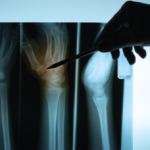Broken hips are among the most serious injuries incurred by older adults, and many fractures are preventable. According to the Centers for Disease Control and Prevention (CDC), approximately 300,000 people over the age of 65 are hospitalized each year for hip fractures, with women (who have lower bone density than men) experiencing three-quarters of all hip fractures.
The Issue at Hand
Although dual-energy X-ray absorptiometry (DXA) is considered the gold standard in measuring bone density, diagnosing osteoporosis and helping prevent fractures, many physicians are finding it cost prohibitive to offer this service in their private practice.
“The [CMS] has cut DXA reimbursement in the private practice setting by more than 75% since 2007,” says Chris Phillips, MD, a rheumatologist in private practice in Paducah, Ky., and chair of the ACR’s Insurance Subcommittee. “The rate was $140 in 2007 and dropped to $42 in 2018.”
The ACR’s Response
Dr. Phillips and other members of the ACR have attended advocacy meetings in Washington, D.C., to support legislation for the Increasing Access to Osteoporosis Testing for Medicare Beneficiaries Act (H.R. 2693/S. 283). If passed, this would set the minimum for Medicare reimbursement at $98, ensuring bone density testing can be performed for more patients. The CMS has raised the reimbursement rate for DXA testing in the hospital setting, but the ACR would like to see rates raised in the private practice setting as well.
“It’s currently not cost effective for many physicians to replace older DXA machines when they break,” Dr. Phillips says. “We once had 22,000 DXA providers; today, there are less than 16,000. This can make testing difficult for patients who live in a rural area and don’t have easy access to a hospital.”
Why It’s Important
Dr. Phillips notes that raising reimbursement rates makes sense, because fractures in older adults often result in poor medical outcomes. A recent study found that one in three adults age 50 and older dies within 12 months of suffering a hip fracture.
“We’ve seen a 50% decline in DXA testing over the past decade,” says Ken Saag, MD, MSc, a rheumatologist in Birmingham, Ala., current ACR secretary and past president of the National Osteoporosis Foundation. As DXA testing has declined, doctors have seen an increase in the number of hip fractures reported among older adults. “Hip fracture rates had been on the decline, but in 2013, hip fracture rates leveled off and in some age groups, were even higher,” says Dr. Saag.
One study found that between 2014 and 2015 fracture rates in women aged 65–69 rose by 2.5% and in women aged 70–74, they rose 3.8%.
“Osteoporosis is underdiagnosed in the Medicare population, and the current rate of reimbursement doesn’t make it feasible for many physicians in private practice to purchase new DXA devices,” Dr. Saag says. “As society ages, it’s [crucial] to have access to inexpensive bone density testing so we can prescribe treatments and in many cases, lower [our patients’] risk of sustaining a fracture by 50% or more.”
Make Your Voice Heard
The Senate Committee has recently taken up fall prevention as a focus and the committee chair, Sen. Susan Collins (R-Maine), is the lead for the Senate bill, S. 283. Thus, Dr. Saag encourages ACR members and patients to send a message to their senators and representatives, urging them to protect access to DXA. The ACR has made it easy to do this: A pre-composed e-mail can be found at https://www.votervoice.net/mobile/ACR/Campaigns/63028/Respond.
Linda Childers is a California-based journalist who contributes health articles to a number of national media outlets. Her stories have appeared in The California Health Report, Arthritis Today, Neurology Now, Nurse.com, Minority Nurse, Lifescript.com and many other publications. An award-winning writer, Ms. Childers lives in the San Francisco Bay Area with her husband, son and rescue dog.

